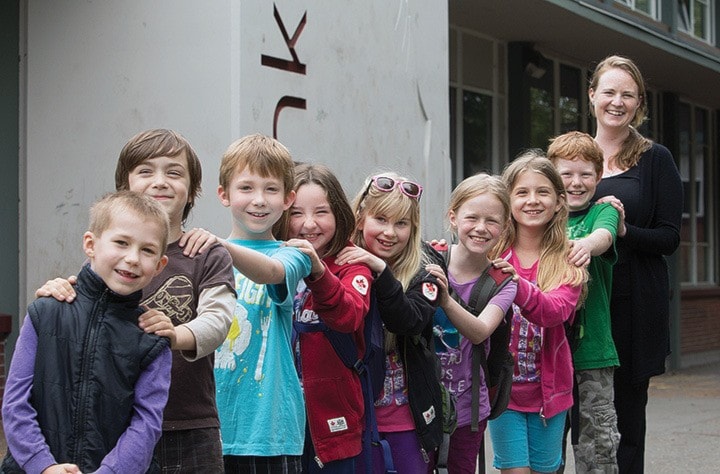Coun. Michelle Kirby is talking the talk, hoping future students walk the walk.
With traffic and parking issues coming to a head in several school-side neighbourhoods, Kirby is seeking solutions before they end up as neighbourhood disputes. The answer in part, she said, is a model of active transportation, a global programming infrastructure implemented by partnership between the municipality, schools and the public.
“I think we have to work together, it’s too big an issue for just a school principal to handle. I think without collaboration and some kind of cohesive plan we work on together, we won’t see improvement,” Kirby said. “My hope is that we see the five municipalities in school district 61 collaborating.”
Kirby points to building lifestyle infrastructure for walking school busses, bike trains to and from schools with rides and walks customized to individual communities, including Oak Bay, as investments that concurrently promote healthy and active living for tomorrow and help the environment by reducing carbon emissions from vehicles. She hopes, in essence, to turn bike to school week, into bike to school year.
“Why can’t we have paid train leaders and walking school bus leaders so there is a consistent leader there Monday to Friday always available?” Kirby asked. “(Then) parents can count on someone ensuring their child safely goes to school using the bike train or walking school bus.”
She hopes to implement a system from the Hub for Active School Travel (HASTe), a non-profit society funded in part by the Ministry of Environment, which helps schools develop personalized safe and sustainable travel to and from school. But the system hinges on using a paid facilitator to work between three to five local schools. The facilitator, potentially funded in partnership with neighbouring municipalities, would be the frontline, with a mix of volunteers and paid staff to operate the programs throughout the school year.
The proposal would need time to fully form because no single model works for every school, but would essentially offer safe transit to and from the school property using multiple, carefully planned biking and walking routes, engineered in cooperation with major partners and mapped out by professional cartographers.
HASTe community programs manager Kerry Hamilton said the long-term benefits extend far beyond just helping neighbourhoods and schools get along.
“We need to start looking at the built environment and how that has dictated our behaviours in our community,” she said. “It’s not just going to the gym that’s going to make the change. Active transportation, and this work in particular, is going to teach children how to be active throughout their day, throughout their lifetime. It’s about creating communities so that we can walk in them from (ages) eight to 80.”
The process has already begun in communities up Island, including in Comox, which hired a part-time facilitator trained through HASTe, who now works with three local schools operating the active transportation program year round. Other communities using the program, which costs approximately $10,000 per school as a one-time start up fee, include a school in Surrey which increased its active travel to school by 14 per cent and in New Westminster, which reduced the number of students driven to school by 17 per cent within two years of implementing the HASTe program.
The $10,000 cost is broken down to HASTe staff working in the community, surveys and evaluation of the routes, the building of the best route maps with professional mapmakers and project management.
Kirby spearheaded a meeting at Oak Bay municipal hall last week, inviting approximately 40 potential partners including numerous Oak Bay residents, Victoria Police, the City of Victoria, the town of View Royal and the Vancouver Island Health Authority,
“I think it was great the turnout we had the other day,” said attendee Vancouver Island Health Authority public health nurse Carly Westwood. “(To see) the diversity of community stakeholders interested in something like this and in the overall health and well-being of our kids.
“We need to be doing more of this – developing and engaging community – and building back community. … The sense of knowing your neighbours has been lost in a lot of communities and bringing that back is important for the health of our kids.”
Hamilton went a step further, saying the benefits will trickle back into the community for years to come.
“Those health benefits, we see in mental health, social health and community health,” she said. “It’s in everything and you will see it at the end of the day in the economic health of the community.”
For more information visit hastebc.org.
